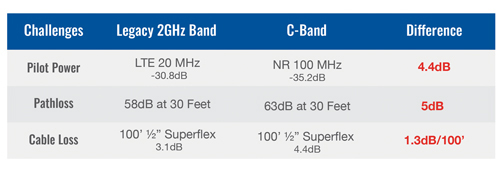Delivering Pervasive In-Building
Wireless Connectivity with CBRS
By: Slavko Djukic, VP Product Line Management & Technology - SOLiD Americas

Today's mobile subscribers demand quality service everywhere, all the time – from commercial buildings and event venues to college campuses, manufacturing plants, and subways. Yet delivery of pervasive in-building connectivity presents myriad challenges, particularly as mobile network technologies continue to evolve. How can network operators and system integrator ensure quality in-building service?
Tackle RF Challenges
Although mobile networks provide pervasive wide-area coverage in most cities and suburbs worldwide, many legacy radio frequency (RF) bands do not penetrate building materials very well. This means that energy-efficient windows, neighboring buildings, and other nearby obstacles easily block outdoor network signals. As a result, mobile device users typically experience poor quality of service (QoS) indoors — where roughly 80 percent of all mobile voice and data traffic occurs.
Traditionally, many building owners, system integrators, and third-party network operators have addressed this in-building connectivity challenge by deploying neutral host distributed antenna system (DAS) equipment. Yet, each deployment is unique, and a number of factors need to be evaluated to determine the type of DAS platform best suited to the job and the way in which it’s deployed. The building size, materials, and layout all play an important role, as well as the intended in-building use cases. Is it a commercial property with retail tenants, a hospital campus, or a multi-story office building? Perhaps a sports stadium or music venue is in need of expanded capacity to support a multimedia fan experience.
About Promptlink - www.promptlink.com
Promptlink Communications is an industry innovator in network noise detection and CPE testing, with 15 patents demonstrating the innovation and breakthrough technology Promptlink
has developed. One key innovation has led to solving the puzzle of localizing and repairing ingress and other types of HFC noise and impairments. Machine learning and a huge library
of labeled data is used to identify the type of noise or other impairment and sends the specific location directly to a technician, with no analysis required. Promptlink’s Network
NoiseHawkAI provides a fully-automated solution for localizing, diagnosing and repairing Upstream Noise and other impairments. NoiseHawkAI automatically localizes a point in your
network, provides instructions to find and fix the issue, and validates the fix. All steps are fully automated, using the latest AI technology to send all info straight to a
smartphone. Promptlink's patented and award-winning solution is one-of-a-kind. This is only one of many unique solutions provided by Promptlink.
More importantly, proper DAS configuration and deployment will require knowledge of which spectrum is in use in the nearby mobile network cell sites, and the signal propagation characteristics of each RF band. For example, the recently available 5G mid-band frequencies, such as the C-band spectrum, are even more easily attenuated than legacy mobile frequencies, so these transmissions are even more readily impeded by interior walls, cubicles, furniture, and other clutter than frequencies used for legacy 3G and 4G transmissions. As more mobile network operators (MNOs) build out 5G networks using mid-band frequencies, legacy DAS equipment requires upgrades to support the new frequency bands, and additional DAS modifications may be needed to maintain seamless in-building 5G coverage.
Tailor DAS Deployments
Because the mid-band spectrum provides access to larger channels than legacy bands, the C-band and other mid-band 5G frequencies offer significantly greater capacity for wide-area network deployments. However, these wider channels also consume more radio output power, reducing the effective coverage area. Therefore, to achieve the same in-building coverage footprint using the mid-band spectrum, existing DAS installations will require upgrades, such as antenna replacements and increased output power. (see Figure 1)

Figure 1. C-Band Challenges
Likewise, the C-band provides a shorter signal propagation range as well. In fact, C-band coverage per antenna is a small percent of the in-building coverage provided by some legacy frequencies at the same power level. That means that in an office environment with sheet rock walls, an antenna providing a little more than 10,000 square feet of coverage with a 4G 20 MHz-wide channel may only cover around 3,000 square feet with a 5G 100 MHz-wide channel in the C-band. In this scenario, the upgraded DAS equipment would require amplifiers that provide 4 to 10 times more output power to match the existing footprint (see Figure 2 on next page). Similarly, a growing number of network operators are turning to mid-band Citizens Broadband Radio Service (CBRS) spectrum for private in-building and campus networks, due to the relative speed and lower cost of deploying unlicensed spectrum. In this way, network operators and enterprises can realize the promise of the Internet of Things (IoT), enabling a variety of secure Industry 4.0 use cases, including predictive maintenance, real-time asset tracking, manufacturing automation, and occupational health and safety. Yet, the ability to reliably implement this type of private 5G network requires careful in-building network planning to ensure mission-critical connectivity.




















